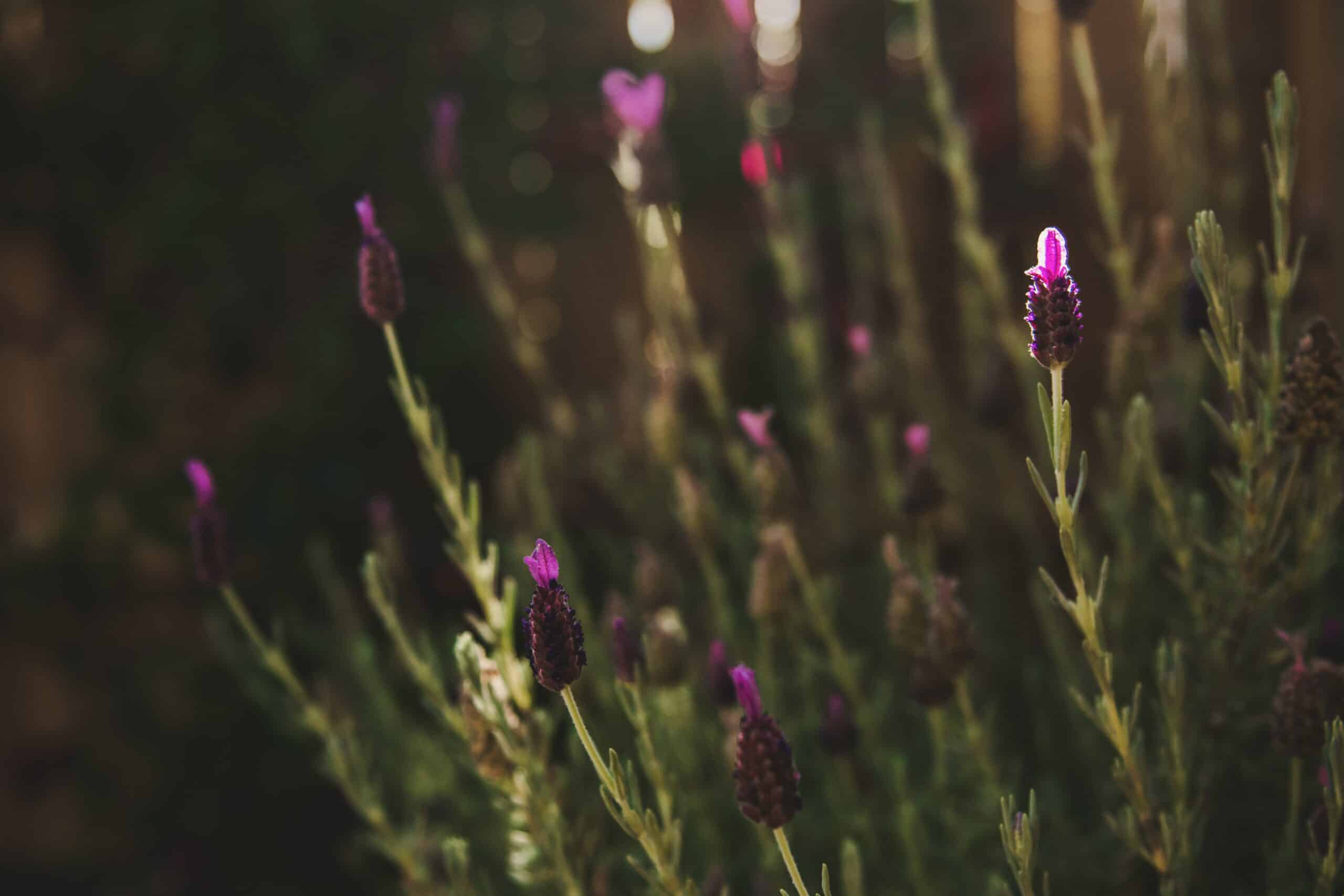Spanish Lavender is a versatile and attractive plant that can bring beauty and color to any garden. In the United States, it is one of the most popular choices for landscaping and home gardens, with over 100 million seeds sold each year! Whether you are an experienced gardener or just starting out, this guide will provide you with helpful tips on how to successfully care for and grow Spanish Lavender.
For those looking to add a pop of color to their garden, Spanish Lavender is an excellent choice. With its long-lasting blooms in shades of purple, pink, or white and its pleasing scent, it’s no wonder so many people are drawn to this lovely plant. It’s easy to grow in many climates and requires only minimal maintenance once established. With a few simple steps, you can easily enjoy the colorful beauty of Spanish Lavender in your own yard!
In addition to bringing beauty to your garden, Spanish Lavender also offers many practical benefits. Its fragrant scent helps deter pests such as mosquitoes while also releasing calming aromatherapy properties into your outdoor space. Plus, its strong stems make it great for adding structure and height when used as a border plant or background plant in landscaping designs. If you’re looking for a multi-purpose plant that will keep your garden looking beautiful all season long, then look no further than Spanish Lavender!
Identifying Spanish Lavender
Spanish lavender is an enchanting plant, with its wispy silver-green foliage and vibrant purple-blue blooms. Its delicate beauty has long captivated gardeners, who have been cultivating it for centuries. Identifying Spanish lavender is the first step to adding this stunning shrub to a garden or landscape.
The shrub can vary in size from species to species, but generally grows between one and three feet tall and wide. It is an evergreen perennial that thrives in hot, dry climates and requires well-draining soil. Its foliage has a distinct sweet scent that some liken to bubblegum. The flowers of Spanish lavender are trumpet-shaped and range in color from purple to blue. They bloom throughout the summertime months of June through August.
Spanish Lavender is often confused with other varieties of Lavender due to their similar appearance. A good way to distinguish them is by looking at their leaves; Spanish Lavender’s foliage is much softer than other types of Lavender and has a slight grayish hue, while English lavenders have gray-green leaves that are more rigid. Additionally, the flowers on Spanish Lavender tend to be larger than those on English varieties. With its unique beauty and fragrant aroma, adding this captivating plant to your outdoor space will surely be rewarding!
Planting Spanish Lavender
Planting Spanish Lavender is like planting a garden of joy. It’s an easy process that can bring a burst of vivid colors and scents to your outdoor space. To get started, set the stage for success by selecting the right location in your garden. Choose an area with plenty of sun and good drainage, as these conditions are essential for Spanish Lavender to thrive.
Once you’ve found the perfect spot, it’s time to actually get planting! Plant your lavender in spring or fall, digging a hole twice as wide as the root ball. Then, backfill the hole with soil mixed with compost or fertilizer to give your lavender a nutrient-rich environment. Water deeply after planting and mulch around the base for extra insulation and moisture retention.
With proper care and patience, you’ll soon be rewarded with bountiful blooms of stunning purple flowers that attract bees and other pollinators. You can also enjoy its lightly fragrant aroma wafting through the air on warm summer days – what better way to add beauty and life to your outdoor space?
Sunlight Requirements For Spanish Lavender
Sunlight is an essential factor when it comes to growing Spanish lavender successfully. Without the right amount of sun, this plant won’t be able to reach its full potential. Let’s take a closer look at what kind of sunlight Spanish lavender needs in order to thrive.
When it comes to choosing a spot in your garden for Spanish lavender, you’ll want to make sure that it gets plenty of direct sunlight throughout the day. This perennial enjoys long hours of direct sunlight, so aim for at least 6-8 hours each day. If you live in a particularly hot climate, though, then you should avoid exposing your plants to any more than 8 hours per day as too much sun can cause damage or even kill them.
But don’t worry if you don’t have a sunny spot in your yard; Spanish lavender can also grow well in partial shade. In this case, however, your plants may not flower as abundantly and will produce fewer essential oils. So if you’re looking for maximum blooms and fragrances from your Spanish lavenders, then give them all the sun they need! With the right amount of sunlight, these beautiful plants will reward you with their amazing color and scent.
Now that we’ve gone over the importance of sunlight for Spanish lavender growth, let’s move on to discussing soil requirements…
Soil Requirements For Spanish Lavender
Soil requirements for Spanish Lavender – it’s not just sunshine that this beautiful plant needs. To thrive, it also requires a specific type of soil. Juxtapose this with the fact that it is an easy-to-grow and low-maintenance plant, and you have yourself one of the best flowering shrubs to enjoy in your garden! Here are four things to keep in mind when considering soil needs for Spanish Lavender:
- It prefers loose, well-drained soil with a pH range of 6.2 to 8.2;
- The soil should be slightly alkaline;
- Sandy loam is ideal;
- It should be amended with organic matter such as compost or manure before planting. These simple steps will help ensure that your Spanish Lavender has all the necessary ingredients for optimal growth and development. With the right kind of soil, you can provide this flowering shrub with what it needs to thrive – and give you plenty of pleasure in return! But don’t forget about water – that’s another essential ingredient for success in growing Spanish Lavender.
Watering Spanish Lavender
Watering Spanish Lavender is a delicate balancing act. Too little, and the plant will suffer; too much, and the roots may rot. It is a crucial part of keeping this fragrant flower alive and thriving.
Let’s begin with the basics: water should be applied generously but infrequently to prevent root rot, ensuring that soil is completely dry before adding more water to the area. When you do water, try to make sure it reaches several inches into the ground for optimal absorption. However, during hot summer months or in very dry climates, supplemental watering may be necessary even when soil isn’t completely dry – just make sure not to overwater!
Now that we have the basics down, let’s talk about when it’s best to water your lavender plants. Generally speaking, it is best to water once or twice a week during spring and fall while increasing frequency slightly in summer months where temperatures are higher. As always, keep an eye on your plant’s condition and adjust your watering schedule accordingly – if your lavender looks wilted, give it some extra love with a good watering session!
With just a bit of attention and care, you can ensure that Spanish Lavender has everything it needs to grow strong and healthy. With these tips in mind, you are now ready to move onto fertilizing – another crucial part of caring for this beautiful flower!
Fertilizing Spanish Lavender
Taking care of Spanish Lavender is no walk in the park. With the right approach, however, you can reap a bountiful harvest of fragrant blooms. Fertilizing is an important part of proper care for this plant, and it pays to know how to do it correctly.
First and foremost, it’s important not to over-fertilize your Spanish Lavender plants. Too much fertilizer can cause damage and stunt growth. A good rule of thumb is to feed your plants just enough so that they remain healthy, but not too much that their foliage turns yellow or brown. To achieve this balance, use a balanced fertilizer such as 10-10-10 once every 6 to 8 weeks during the growing season.
Organic fertilizers are also an option as they provide vital nutrients while also supporting beneficial microorganisms in the soil. Manure, compost or mulch made from organic materials are all great options for feeding your Spanish Lavender plants. Applying these fertilizers around the base of the plant will help ensure its long-term health and strength while also providing nourishment directly to its roots.
The key is to be mindful when using any kind of fertilizer and give your Spanish Lavender only what it needs; too little or too much can have detrimental effects on its growth and health. With that said, proper fertilization is essential for keeping your Spanish Lavender looking vibrant and beautiful all season long!
Pruning Spanish Lavender
Pruning Spanish Lavender is a great way to keep your plants healthy and vibrant. If done correctly, pruning will help encourage new growth, as well as enhance the beauty of the plant. It’s important to note that pruning should be done at the right time, in order to get the most benefit from your efforts.
When it comes to pruning Spanish Lavender, you’ll want to wait until after the plant has finished blooming for the season. This allows you to get the most out of its flowering cycle. You can also do some light pruning during the summer months; however, make sure not to remove too much foliage or you may reduce its fullness and overall bloom size.
When pruning your Spanish Lavender, always use clean, sharp scissors or shears and take care not to damage any of the stems or branches. Make sure that all of your cuts are made at an angle so that water can properly drain away from the cut area. Additionally, make sure that you never remove more than one-third of the foliage from each stem or branch at a time; this will help ensure that your plant stays healthy and has plenty of foliage for photosynthesis. With these tips in mind, you’re ready to start pruning your Spanish Lavender!
Now that we’ve discussed how to properly prune Spanish Lavender, let’s move on to propagating it.
Propagating Spanish Lavender
You won’t believe what a coincidence this is – propagating Spanish lavender can be incredibly rewarding! It’s not just the beautiful blooms and pleasant scent, but it’s also the knowledge that you are preserving a unique species. There are several approaches to propagating this plant, each of which offers its own advantages. Let’s take a look:
Taking cuttings: This method involves taking cuttings from mature plants and growing them in soil or water. It is important to choose young stems as they will have more success in taking root.
Division: If your Spanish lavender has become too large for its pot or garden plot, you can divide it into smaller sections for replanting elsewhere. This is an easy way to propagate the plant without needing any special equipment or materials.
Seeds: You can also collect seeds from existing plants and start new ones from scratch! This can be done indoors or outdoors, depending on your preference.
No matter which method you choose, propagating Spanish lavender is a great way to enhance any garden space and ensure that these beautiful flowers continue to thrive for years to come. Now let’s move on to learning how we can control pests and diseases affecting our Spanish lavenders…
Controlling Pests And Diseases
Most gardeners want to create a beautiful, vibrant landscape. But sometimes, pesky pests and diseases can interfere with these plans. It’s essential to know how to control them in order to protect your Spanish lavender plant and keep it looking good.
Let’s start by talking about pest control. Common pests that affect Spanish lavender are aphids, mealybugs, and whiteflies. To combat these, you can use insecticidal soap or neem oil. Make sure you spray the entire plant, including the undersides of leaves if possible. You may also want to consider using companion plants such as marigolds or nasturtiums to attract beneficial insects that will feed on the pests.
Next is controlling diseases that could harm your Spanish lavender plant. The most common disease affecting this species is root rot caused by overwatering or poorly drained soil. To prevent this from happening, make sure you only water when the top inch of soil feels dry and make sure your soil has good drainage by planting in raised beds or adding organic material like compost or peat moss. If you notice any signs of rot on your plants, remove affected areas immediately and dispose of them properly so they don’t spread the disease further.
With proper pest and disease control measures in place, you’ll be able to enjoy a healthy Spanish lavender plant for years to come – as well as reap the benefits of companion planting with other herbs and flowers!
Companion Planting With Spanish Lavender
Do you ever feel like your garden is just missing that special something? Well, we have the answer for you – companion planting with Spanish Lavender! Yes, this could be the solution to your gardening woes. Rather than spending hours of your precious time on controlling pests and diseases, why not just plant a bit of Spanish Lavender and get all the benefits of companion planting? Let’s explore how this amazing little flower can improve your garden!
For starters, companion planting with Spanish Lavender is a great way to increase soil fertility. By planting it in combination with other plants, they can benefit from the nitrogen-fixing properties of lavender, resulting in healthier and more productive soil. Plus, its aromatic leaves will help keep pests at bay by masking the scent of other plants and confusing them. Additionally, it will help attract helpful insects such as bees and butterflies which are beneficial for pollination.
Not only that, but Spanish Lavender is also known for its beautiful blooms which will provide a burst of color in any garden. Its delicate purple flowers will bring life to any outdoor space while providing enjoyment for months on end. So if you’re looking for an easy way to spruce up your garden and make it more productive too, then companion planting with Spanish Lavender is definitely worth considering!
Now that we’ve explored how companion planting with Spanish Lavender can help improve your garden let’s move onto harvesting this versatile flower...
Harvesting Spanish Lavender
The sweet scent of Spanish Lavender fills the air and invites you to come closer. Its delicate purple flowers are a feast for the eyes, providing an unexpected beauty in any garden. As you explore the secrets of this aromatic herb, harvesting Spanish Lavender is one of the most rewarding tasks:
- You can easily collect its flowers and leaves with your hands or scissors.
- The best time to harvest is after the first blooming period when the flowers are still fresh and in full bloom.
- Make sure to take only a few stems at once so as not to damage the plant’s production ability.
Harvesting Spanish Lavender provides a myriad of uses, from simple decoration to medicinal remedies and even culinary delights. You can use it in many ways, such as drying it for sachets or making herbal tea. Whether you’re looking for an easy way to brighten up your home or some natural healing powers, Spanish Lavender has something special just waiting for you!
Uses For Spanish Lavender
The sweet, heady scent of Spanish Lavender wafts through the air, like a warm embrace from an old friend. As it blooms in shades of pink and purple across sunny gardens, this hardy and fragrant plant has become a favorite among gardeners and homeowners alike. Now that we have harvested our Spanish Lavender, let’s look at some of the ways we can use it in our everyday lives.
From aromatherapy to home decor and culinary delights, Spanish Lavender is incredibly versatile. For starters, it’s great for crafting potpourri or adding dried leaves to sachets to make your clothes smell fresh and inviting. You can also place the flowers in a vase as a natural centerpiece with added fragrance, or add them to homemade candles or soap for an extra-special touch.
In the kitchen, lavender adds an interesting flavor note to many dishes, including baked goods like cakes or shortbread cookies. You can also infuse oils with lavender buds for salad dressings or flavoring drinks like lemonade or cocktails. With its unique flavor profile and beautiful blooms, you’ll never run out of ideas when it comes to using Spanish Lavender!
With so many creative uses, there’s no doubt that Spanish Lavender is a must-have for any avid gardener – next up, let’s explore how to troubleshoot any potential problems along the way!
Troubleshooting Spanish Lavender Problems
It’s ironic that while Spanish Lavender is known for its beauty and hardiness, sometimes it still has its troubles. Despite its resilience, it can still have its share of problems! From pest infestations to disease, there is a range of issues that can occur when growing the plant. But don’t worry—here’s how to troubleshoot common issues:
• Pest Infestation: o Look for signs of pests like aphids or whiteflies. o If present, you can use insecticidal soap or neem oil to rid them from your plant. o Keep the area around your lavender clean and free of debris to prevent future infestations.
• Disease: o Check for signs of fungal diseases like powdery mildew or root rot on your lavender plants. o Remove affected parts and apply fungicides as needed. o Consider watering in the morning so the leaves dry quickly in the sun and reduce the chance of disease occurring again.
• Environmental Stressors: o Make sure your lavender is getting adequate sunlight and water. o Create good air circulation around the plant by pruning away any dead branches or leaves. o Mulch annually with organic material to help keep weeds from growing near your lavender plants and improve soil drainage.
With these tips in mind, you’ll be well-equipped to tackle any Spanish Lavender problems that come up—now let’s move on to winterizing this resilient plant!
Winterizing Spanish Lavender
Winterizing Spanish Lavender is essential for its survival during the cold winter months. By taking a few simple steps, you can ensure that your plants remain healthy and vibrant until spring arrives. Here’s what you need to do:
- Cut back the plants in late summer or autumn. This will help protect them from frost damage.
- Cover the plants with a thick layer of mulch to help insulate them from cold temperatures.
- Water the plants regularly before and throughout the winter season to keep them hydrated.
Additionally, consider bringing potted Spanish Lavender indoors if you live in an area where temperatures drop below freezing. This will provide extra protection against frost and snow damage. Be sure to keep the pot in a bright, warm location, as too much heat can cause the plant to become stressed out and prone to disease.
Taking these precautions will help keep your Spanish Lavender safe through even the harshest of winters so they can thrive come springtime. With proper care and attention, these hardy perennials can bring beauty and fragrance to your outdoor space for years to come. As you move forward into creating gorgeous Spanish Lavender landscapes, remember that it all starts with winterizing your plants for success!
Creating Spanish Lavender Landscapes
When it comes to Spanish Lavender, creating a beautiful landscape should be your goal. Its sweet scent and vibrant purple flowers will add a sense of beauty and harmony to any outdoor space. But how can you create the perfect landscape for your Spanish Lavender? Let’s find out!
To get the best results, you’ll want to think carefully about where to plant the lavender. Choose an area that gets plenty of sunshine, as this is essential for keeping your plants healthy and happy. Make sure the soil is well-draining so that your lavender doesn’t become waterlogged. You’ll also want to consider whether your location is windy or not – lavender doesn’t like too much breeze!
Once you’ve chosen a suitable spot, it’s time to start planting. For best results, space each plant about 12 inches apart and water them regularly but not too much. Prune back dead branches every spring and give them an occasional feed of fertilizer in summer months to keep them blooming all season long. With a little bit of care and attention, you’ll soon have a stunning landscape filled with fragrant Spanish Lavender!
Frequently Asked Questions
What Type Of Climate Is Best For Growing Spanish Lavender?
The fragrant beauty of Spanish Lavender is a sight to behold, and its aroma can bring joy to any garden. Yet, like all plants, it has specific requirements that need to be met in order for it to flourish. When it comes to climate, Spanish Lavender prefers sunny and dry conditions – much like a sunbather soaking up the rays of summer.
Growing Spanish Lavender in climates with mild winters and warm summers is ideal; however, if you live in an area that experiences cold temperatures during the winter months, there are ways to keep your plant safe and healthy. First off, choose a spot with good drainage as wet soil could cause root rot. Secondly, provide protection from strong winds by planting near a wall or fence. Lastly, mulch around the base of the plant when the temperature drops below freezing point.
With these guidelines in mind, you can create the perfect environment for your Spanish Lavender to thrive like never before! By taking into account its climate needs and providing adequate care and attention throughout the year, this captivating bloom will fill your garden with floral delight – now that’s something worth striving for!
How Often Should Spanish Lavender Be Pruned?
Spanish lavender is an attractive and fragrant flowering plant that adds beauty to any garden. However, it’s important to prune the plant properly in order to ensure its health and growth. According to the Royal Horticultural Society, up to 40% of a shrub’s growth can be removed each year without harming it. Here are three tips for pruning spanish lavender:
Start by removing dead and diseased wood. Dead wood has no new growth, is usually grey or brownish in color, and may be hollow inside. Diseased wood is darker in color than healthy wood, sometimes with streaks of yellow or orange.
Next, remove about one-third of the branches back to their point of origin. This encourages strong new stems that are less likely to break under the weight of flowers.
Finally, trim off any remaining weak shoots at the base of the plant so they don’t take away essential resources from more vigorous ones.
When done correctly and regularly, pruning spanish lavender will promote healthier plants with better blooms and improved overall health. Additionally, regular pruning helps keep the plant looking neat and tidy throughout its growing season; generally once or twice per year should suffice!
Does Spanish Lavender Attract Pollinators?
Do you want to attract pollinators to your garden? Spanish lavender might be the perfect plant for you! This fragrant plant produces beautiful purple blossoms that not only add color to your garden, but also act as a magnet for bees, butterflies, and hummingbirds. But how often should you prune this plant in order to keep it blooming?
Pruning is an important part of caring for Spanish lavender. Pruning helps the plant retain its shape and encourages it to produce more flowers. It’s best to prune Spanish lavender in late winter or early spring before new growth appears. However, if you’re looking for a way to bring additional pollinators into your garden, then consider leaving some of the spent flower stalks on the plants during the summer months; this will help attract even more pollinators!
If you have Spanish lavender in your garden and are looking for ways to attract pollinators, consider leaving some of the dead flower stalks on the plants during summer months. This will help bring more bees, butterflies and hummingbirds into your garden so that they can enjoy this fragrant plant’s gorgeous purple blossoms!
Are There Any Special Requirements For Growing Spanish Lavender In Containers?
Do you want to grow Spanish lavender in containers, but are concerned about special requirements? Don’t worry! With the right care and environment, you can easily grow Spanish lavender without any extra effort. Here are some tips that can help:
First, it’s important to provide enough space for the roots of your Spanish lavender. This means using a pot with good drainage and plenty of room for the root system. Additionally, be sure to use a well-draining soil mix and water your plant regularly when the soil feels dry.
Second, it’s important to provide adequate sunlight for your plant. Place it in a spot that gets at least four hours of direct sunlight per day and keep it away from cold drafts or areas with high humidity. It also helps to add an occasional liquid fertilizer during its growing season to ensure optimal growth.
Finally, pruning is an essential step in keeping your Spanish lavender healthy. Pruning will encourage new growth and help shape the plant as desired. Be sure to start early in the spring before new growth appears, and then trim back any stems that are overgrown or dead during the summer months. With these easy steps, you can enjoy beautiful Spanish lavender year round!
How Long Does Spanish Lavender Typically Bloom?
Spanish lavender is a beautiful, fragrant flower that makes a great addition to any garden. When the petite purple blooms appear in the late spring and summer months, they offer a stunning display of color that can last for weeks on end. As a gardener, you may be wondering how long these beautiful flowers will last in your garden–how long does Spanish lavender typically bloom?
The answer is that Spanish lavender typically blooms for about 6-8 weeks. The exact length of time actually depends on the variety of Spanish lavender you are growing, as well as your local climate and weather conditions. For example, if you live in an area with cooler temperatures or more frequent rainfall during the summer months, then your flowers may not last quite as long as someone living in an area with warmer temperatures and less rainfall during the same period.
However, no matter where you live or what type of Spanish lavender you have planted in your garden, there are several things you can do to ensure that your flowers stay healthy and vibrant for as long as possible:
• Provide Proper Care: Make sure to water your plants regularly and fertilize them every couple of weeks with a balanced fertilizer to keep them healthy and strong. Additionally, deadhead spent blooms and trim off any damaged or diseased stems or leaves to encourage new growth.
• Protect from Pests: Keep an eye out for any pests such as aphids or spider mites that may be trying to take up residence on your plants and treat them accordingly with an appropriate pesticide.
With proper care and protection from pests, you can enjoy the beauty of Spanish lavender for up to 8 weeks throughout the summer season! The stunning purple blooms will add color, texture, and fragrance to any outdoor space; it’s no wonder why so many people love this plant so much.
Conclusion
The Spanish Lavender is a beautiful, fragrant flower that can add a touch of elegance to any garden or outdoor space. It is a hardy plant and fairly easy to take care of, making it an ideal choice for those looking to spruce up their outdoor spaces. With the right climate, proper pruning, and special container considerations, this colorful flower can bloom for many months each year. The beauty of Spanish Lavender is like a bouquet of flowers in your garden- brightening up your day with its soft scent and vibrant colors.
The Spanish Lavender may require some extra attention but with the right care it will reward you with its stunning shades of purple blooms throughout the season. By understanding what type of climate and how often to prune it, you can enjoy its beauty while attracting pollinators to your garden as well. Knowing how long it typically blooms and any special requirements such as containers will help ensure that you get the most out of this delightful flowering plant.
When cared for properly, the Spanish Lavender can bring life to any outdoor space with its rich colors and wonderful aroma. This gorgeous flower is sure to become an eye-catching centerpiece in any garden or landscape design. Not only does it provide visual appeal but also benefits other plants by attracting pollinators while adding beauty and fragrance throughout the season.





























